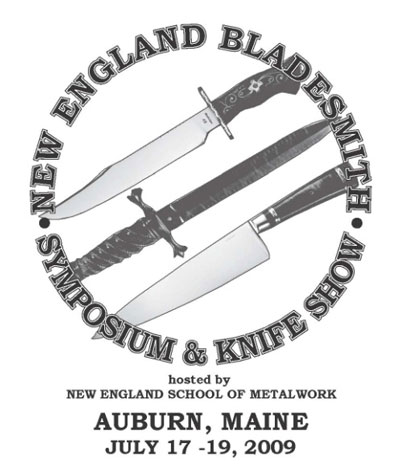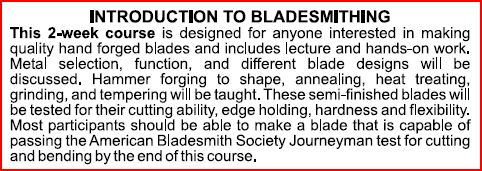Hello Good People,
I'm bewildered about a couple of things. I believe this is the third summer that I hoped there would be an ABS Bladesmithing Intro class scheduled somewhere, but alas I don't see any. I wonder why not?
Another point of mystery for me is, where/when is blade finishing taught? From the description I've found about the Intro class on the ABS website (via Texarkana's brochure) it seems not to be addressed much in that class. And, the Handles and Guards class description states to bring already finished blades to the course. Am I missing something?
Thanks Friends!
Phil
Phil,
The finishing of a blade is taught in the Intro class.
Phil:
Those are good questions. I know that you are a teacher and only have summer available. I will check with the ABS coordinators for the three schools and see if they have plans to add a summer Intoduction to Bladesmithing class at either Texarkana College, Haywood College, or the New England School of Metalwork.
In regard to your second question, hand finishing a blade is usually one of classes taught at the most of ABS Hammer-Ins that we have around the country. Last summer Master Smith Russ Andrews made an excellent presentation at the Mid-America Hammer-In held in Troy, Ohio and it was captured on DVD and is available in the ABS Store. I gave a presentation on hand finishing a blade at the New England Hammer-In at the New England School of Metalwork, in Auburn, Maine in July of 2009 and have attached a copy of my class handout.
“The Hand Finished Bladeâ€
by Dan Cassidy, Journeyman Smith
- Hand finishing begins after forging, grinding, heat treating, and the cutting edge is established on the grinder.
- There are many different techniques and tools used and I have learned different methods to perform this task from several ABS Mastersmiths and Journeyman Smiths. Which method is the best? You will have to try different methods and do what works best for you.
- In this presentation I want to show you not only what works for me but also other methods used by ABS members that may work for you.
- Most start at 220 grit but some start as low as 120 or as high as 400 grit. Some use automotive paper that comes in sheets and others use Klingspor shop rolls.
- I usually start at 220 grit and begin on the bottom of the Ricasso then top of the spine.
- I place the knife on a jig that has a flat metal surface with leather on the bottom and clamp the tang down tight with no flex in the blade. The jig is set in a bench vise.
- Lubrication used- Some use water, Windex, WD40, or nothing. I have tried all of these and now use WD 40.
- Tools- Among the tools used as a sanding stick by some for hand finishing are: files, metal bars, hardwood sticks with rubber or leather attached, Popsicle sticks, Corian blocks, and used planner blades. You can turn the sanding stick up on its edge to address a trouble spot in the blade.
- Excellent lighting and Optivisors- You need excellent visibility to see your work. I use a lamp equipped with a 100 watt spotlight bulb and another lamp with florescent lights focused directly on the blade and wear Optivisors.
- Lights in Atlanta in the judging rooms are brutal and show every imperfection in the finish.
- I start usually start with 220 grit paper over a large flat file. You must be very careful.
- Contour at the cutting edge.
- At 320 grit and above leather over the sanding stick provides a little needed give.
- Last pass or stroke for each grit from 400 and higher is one full length motion from the ricasso to the end of the point with a little water or oil on new paper.
- Use blue tape on blade before final on other side or it will wick and etch the finished side.
- Use 3M Micro pads for the final grit- Rio Grande Supply Co.
- How many strokes? Some say 50 full length strokes per grit but you do it until done
- Touch up after handle is on can be done by clamping a magnet with blue tape on it in a vise.
- Go down or back a grit to get out stubborn scratches in the blade.
- Use a fine tip magic marker to mark or highlight scratches or dips in the blade that need extra attention.
- Do the ricasso first each time you start a new grit
- Carefully clean the surface of the blade off in between grits
- EDM Stones – 180, 220, 320, 400 and 600 grits from MSC in ½ x ¼ x 6.
- Finish the clip separately- Some hand finish the clip to the same grit as the blade and others finish to a higher grit such as 4,000 grit.
- Note on Clips- use a French curve and magic marker to initially draw the clip on the blade- begin to establish the clip on the grinder at 60 and 120 grits and then use files with the blade in a vise, EDM stones, and finally paper during the hand finishing process.
Last oil on the blade.
Dan Cassidy
Journeyman Smith
Send an email to Dan

The magnet with the tape on it is a new one for me. Thanks Dan!
THANKS guys! I'll look into Russ Andrew's DVD.
I was at your finishing demo In Maine a couple years back, Dan. I both enjoyed and appreciated it and learned quite a bit. Well as much as a fella like me can learn from sitting and watching another person doing the work. Truth be told though, I learn a little better via hands on work than watching demos. Thanks for the refresher notes. A while back, I fabricated a thin beveled bar (15n20) along the lines of the planer blade idea you shared with us.
As I recall you started with a blade already completely ground/filed with the flats, plunges and bevels all "squared" away. I guess the Intro class gets you that far? The only description I can find on the ABS website for courses is in the Texarkana College's 2010 brochure. Here's their bit about about the Intro course.
It looks like the course covers some grinding (very important) a "semi-finished blade." Perhaps the syllabus is different at different schools and with different teachers?
I'm just wondering I guess, as it is unlikely I'll get to a full-on Intro course anytime soon. For a guy like me who gets so little time bladesmithing at home, two solid weeks of working and hobnobbing with experts and fellow aspirants would be a real boost though.
All the best to y'all, Phil
The intro course covers the finish of a blade whether or not you get the time or opportunity to apply it while being there. Since the performance test requires a certain degree of finish be applied to the blade to lessen the likelyhood of a stress riser, it's beyond my imagination that it not be covered. It was covered when I took the class. It's logical that you might not take your test blade to a very high degree of hand sanded finish, but it certainly will be covered for the sake of any other blades you will be forging and finishing while there. After all, some enrollees take the handles and guards class the very next week and have to have some blades finished for that class. It will be up to the individual to apply what he is being taught and/or how far to take it.
Hello Phil. Basically the Intro course does teach some grinding, but not hand finishing. We are mainly concentrating on the forging and heat treating, along with design and metallurgy. Then of course making a knife that will pass the cut and bend test. Unfortunately, grinding is something that really could have a whole week devoted to that alone, the same with hand finishing. Maybe there needs to be a follow up course to the Intro course that teaches finishing the blades and getting them ready for the handles and guards class.
Brion
Brion Tomberlin
Anvil Top Custom Knives
ABS Mastersmith
Lin, Brion, I took the Intro class in 2008 and most of the class was forging and heat treating. It seems that the major complaint from instructors regarding the handles class is that students bring blades that a not finished properly. I think it is a great idea to have a week long class on just hand finishing a blade. This should allow the handles class instructors more time to actually teach the fit and finish of handles and guards.



